课堂观察 Class Observation
浅述licc课堂观察量表和课堂观察模式的实施

浅述licc课堂观察量表和课堂观察模式的
实施
"LICC"(Lesson Observation Instrument for Computer-supported Collaborative Learning)是一种用于课堂观察的量表和观察模式,旨在评估计算机支持的协作学习环境中的课堂实施情况。
下面是对"LICC"课堂观察量表和观察模式的简要介绍:
1. 课堂观察量表:LICC课堂观察量表是一套用于记录和评估计算机支持的协作学习环境中课堂行为和实施的指标。
这些指标包括教师和学生在课堂中的行为、教学活动的特点、学生参与度和互动等方面。
观察者使用量表来进行系统性的课堂观察,并将观察到的情况记录在量表上。
2. 课堂观察模式:LICC课堂观察模式是一种基于"LICC"量表的实施方法。
它提供了一种结构化的方式,以便观察者能够有效地观察和记录课堂中的关键行为和要素。
观察者按照预先设定的指标和标准进行观察,并根据量表中的评分指标对观察到的行为进行评估和打分。
通过使用"LICC"课堂观察量表和观察模式,研究者和教育工作者可以对计算机支持的协作学习环境中的课堂实施进行客观的评估和分析。
这有助于了解教学活动的有效性、学生参与度和协作程度等因素,并为改进教学实践和设计更好的学习环境提供依据。
1/ 1。
英文版课堂观察量表

Evaluator:_______________________Evaluator:_______________________Evaluator:_________________________Evaluator:_______________________Evaluator:__________________________Evaluator:______________________Evaluator:__________________________Classroom Observation Task 8 The learnersThis task may help you to see a lesson from a student‟s points of view.Task: As you arrive in the classroom, choose (privately!) one student to focus on in your observation. Watch this student throughout the lesson and make notes under theEvaluator______________________________ Date____________________________Classroom Observation Task 9 Errors and correctionThis task focuses on learner errors in oral production the teacher or learners deal with Task: Note down some student errors. Categorize each error (e.g. wrong tense, wrongEvaluator______________________________ Date____________________________Classroom Observation Task 10 Thoughts and questionsThis form may help you recall what happened in a lesson and remind you of your own thoughts at that time.For each box, note down a specific thing that you observe in the lesson and thenEvaluator______________________________ Date____________________________Classroom Observation Task 11 Stolen goodsAs you observe the lesson, note down several things that you would like to “steal” from this teacher and the lesson in order to make them part of your own teaching. This may include personal qualities, teaching skills and techniques, activities, classroom atmosphere, etc. Include notes to help you remember any important detail. You may also want to record why you felt good about the stolen goods. Finally, choose something youEvaluator______________________________ Date____________________________Classroom Observation Task 12 What helps people learn?What is there about the activities, the teacher and the students that helps to create conditions for effective learning? What things you observe that seem to play a part in hindering learning?Evaluator______________________________ Date____________________________performances. Place in the space before each statement the number that most nearly1.___________Objectives for this presentation were made clear to students.2.___________Presentation was well planned and organized.3.___________Presentation style was appropriate and effective.4.___________Relevant examples, metaphors and analogies were used to establishconnections with students' previous experiences and learning.5.___________Class time was well used.6.___________Critical thinking and analysis was modeled and encouraged.7.___________Instructional techniques required a majority of students to be actively involved.8.___________Respect for diverse opinions was communicated.9.___________Warm, accepting, open classroom atmosphere was evident.10.___________Instructor interest in information was communicated.11.___________Instructor interest in student learning was communicated.12.___________Instructor mastery of subject matter was clear and thorough.13.___________Appropriate and effective use was made of audio-visuals, computer orother instructional technology to support presentation objectives.14.____________ Related easily with students.15.____________Integrated information from other areas within and outside of her/hisdiscipline.16.____________Was sensitive to feelings of students.17._____________Demonstrated enthusiasm for teaching and learning.18._____________Discovered student misunderstandings and misconceptions.19._____________Students attended to what was happening in class.20._____________Moved around the classroom with ease as interacted with students. Total Number___________Comments on instructorSignature of Observer Date of Feedback。
英语作文课课堂观察记录

英语作文课课堂观察记录In the realm of English composition classes, observation becomes an intrinsic facet, a silent yet illuminating participant. The classroom, a microcosm of linguistic exploration, unfurls its narrative through a spectrum of observations. Herein lies an attempt to encapsulate the essence of such an observant journey without the crutches of conventional transitions or summarizing clichés.At the threshold of the classroom, a mosaic of anticipation adorns the visages of the students. Some wear the cloak of confidence, poised to navigate the labyrinth of syntax and semantics, while others grapple with the tendrils of uncertainty, their pens poised like hesitant dancers awaiting their cue. The atmosphere oscillates between palpable tension and an undercurrent of camaraderie, a silent acknowledgment of the collective voyage about to unfold.Within this tapestry of learning, the instructor assumes the mantle of both guide and storyteller. Their voice, asteady cadence punctuated by the occasional crescendo of enthusiasm, weaves through the room like a gentle breeze, stirring the dormant thoughts of the students. With each anecdote shared and each grammatical nuance dissected, the classroom transforms into a sanctuary of shared discovery.As the discourse unfolds, the dynamics of engagement unveil themselves in myriad forms. The eager nod of comprehension, the furrowed brow of contemplation, and the subtleinterplay of pen against paper orchestrate a symphony of intellectual exchange. Amidst the ebb and flow of dialogue, the boundaries between teacher and pupil blur, giving rise to a symbiotic relationship fueled by mutual curiosity.Yet, amidst the tapestry of academic pursuit, the specter of apprehension casts its shadow. For some, the canvas of expression remains elusive, their thoughts tethered by the shackles of self-doubt. It is here that the true essence of learning reveals itself—not in flawless prose, but in the courage to embrace vulnerability and traverse the winding path of improvement.In the recesses of the classroom, language transcends its utilitarian constraints, emerging as a conduit for self-expression and cultural exchange. Through the prism of English composition, the contours of individual narratives converge, each imbued with a unique hue reflective of personal experiences and aspirations.As the final echoes of discourse fade into the ether, a subtle transformation permeates the atmosphere. In the wake of introspection and collective exploration, the classroom emerges not merely as a crucible of academic rigour, but as a sanctuary of growth and self-discovery. Each observation, a brushstroke on the canvas of learning, contributes to the tapestry of understanding that binds us as seekers of knowledge.In the annals of English composition classes, observation transcends the realm of passive scrutiny, emerging as a cornerstone of experiential learning. Within the crucible of the classroom, amidst the ebb and flow of dialogue, lies a testament to the transformative power of language—atapestry woven not merely of words, but of shared experiences and the enduring pursuit of enlightenment.。
课堂观察-教师互助成长有效途径论文
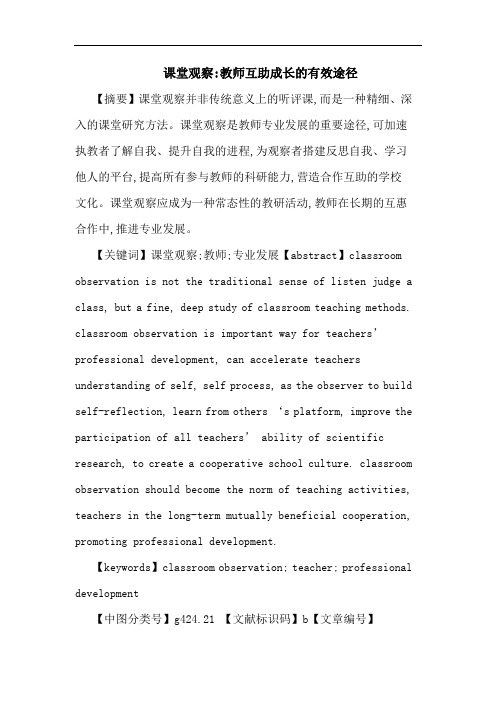
课堂观察:教师互助成长的有效途径【摘要】课堂观察并非传统意义上的听评课,而是一种精细、深入的课堂研究方法。
课堂观察是教师专业发展的重要途径,可加速执教者了解自我、提升自我的进程,为观察者搭建反思自我、学习他人的平台,提高所有参与教师的科研能力,营造合作互助的学校文化。
课堂观察应成为一种常态性的教研活动,教师在长期的互惠合作中,推进专业发展。
【关键词】课堂观察;教师;专业发展【abstract】classroom observation is not the traditional sense of listen judge a class, but a fine, deep study of classroom teaching methods. classroom observation is important way for teachers’professional development, can accelerate teachers understanding of self, self process, as the observer to build self-reflection, learn from others ‘s platform, improve the participation of all teachers’ ability of scientific research, to create a cooperative school culture. classroom observation should become the norm of teaching activities, teachers in the long-term mutually beneficial cooperation, promoting professional development.【keywords】classroom observation; teacher; professional development【中图分类号】g424.21 【文献标识码】b【文章编号】2095-3089(2012)09-0240-021何谓课堂观察?课堂观察,是指研究者(观察者)带着明确的目的,凭借自身感官(如眼、耳等)及有关辅助工具(观察表、录音录像设备等),直接或间接(主要是直接)从课堂情境中收集资料,并依据资料作相应分析的一种教育科学研究方法。
例谈如何进行课堂观察
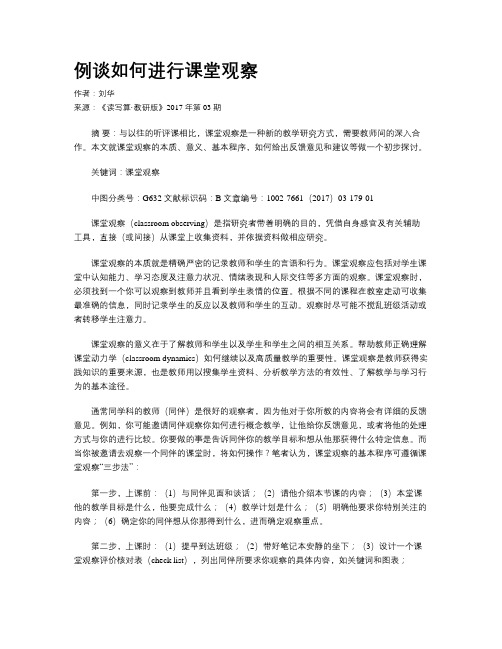
例谈如何进行课堂观察作者:刘华来源:《读写算·教研版》2017年第03期摘要:与以往的听评课相比,课堂观察是一种新的教学研究方式,需要教师间的深入合作。
本文就课堂观察的本质、意义、基本程序,如何给出反馈意见和建议等做一个初步探讨。
关键词:课堂观察中图分类号:G632 文献标识码:B 文章编号:1002-7661(2017)03-179-01课堂观察(classroom observing)是指研究者带着明确的目的,凭借自身感官及有关辅助工具,直接(或间接)从课堂上收集资料,并依据资料做相应研究。
课堂观察的本质就是精确严密的记录教师和学生的言语和行为。
课堂观察应包括对学生课堂中认知能力、学习态度及注意力状况、情绪表现和人际交往等多方面的观察。
课堂观察时,必须找到一个你可以观察到教师并且看到学生表情的位置。
根据不同的课程在教室走动可收集最准确的信息,同时记录学生的反应以及教师和学生的互动。
观察时尽可能不搅乱班级活动或者转移学生注意力。
课堂观察的意义在于了解教师和学生以及学生和学生之间的相互关系。
帮助教师正确理解课堂动力学(classroom dynamics)如何继续以及高质量教学的重要性。
课堂观察是教师获得实践知识的重要来源,也是教师用以搜集学生资料、分析教学方法的有效性、了解教学与学习行为的基本途径。
通常同学科的教师(同伴)是很好的观察者,因为他对于你所教的内容将会有详细的反馈意见。
例如,你可能邀请同伴观察你如何进行概念教学,让他给你反馈意见,或者将他的处理方式与你的进行比较。
你要做的事是告诉同伴你的教学目标和想从他那获得什么特定信息。
而当你被邀请去观察一个同伴的课堂时,将如何操作?笔者认为,课堂观察的基本程序可遵循课堂观察“三步法”:第一步,上课前:(1)与同伴见面和谈话;(2)请他介绍本节课的内容;(3)本堂课他的教学目标是什么,他要完成什么;(4)教学计划是什么;(5)明确他要求你特别关注的内容;(6)确定你的同伴想从你那得到什么,进而确定观察重点。
Topic -- Lesson Observation and Evaluation
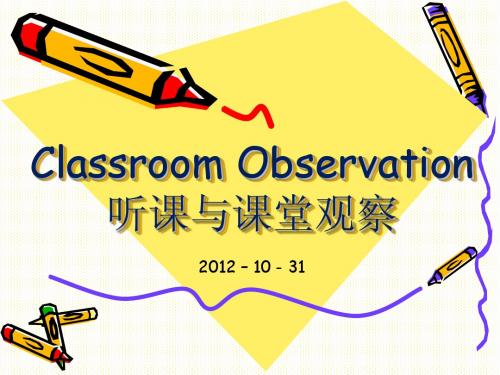
V. What are the different kinds of observation?
2、检查型听课的特点 • 突然性 • 真实性 • 灵活性 3、检查型听课的要求 • 要明确听课的目的 • 要在常态下进行
V. What are the different kinds of observation?
我们根据当前课程改革的要求和教学的实 际情况,结合课堂教学的特点及相对的共 性要求,将听课划分为以下四种: • 检查型听课 • 评比型听课 • 观摩型听课 • 研究型听课
V. What are the different kinds of observation?
• 检查型听课 1、什么是检查型听课? 检查型听课就是为了了解学校和教师教 育教学工作的总体、过程、某一方面或 某个问题的情况而进行的听课活动。
III. What are the purposes of observation?
Based on Franselow’s ideas, the goal of observation is for teachers to see teaching differently.
The goal is to observe other teachers to construct and reconstruct our own knowledge about teaching and
III. What are the purposes of observation?
4. A fourth purpose of observation is to collect data for research purposes. 研究 收集信息
5. A fifth purpose of observation is to be central to an exploratory approach to teacher education. It’s to observe to become more self-aware. 教师教育的一种 途径,使教师通过观察变得更具有自我意f observation?
课堂观察
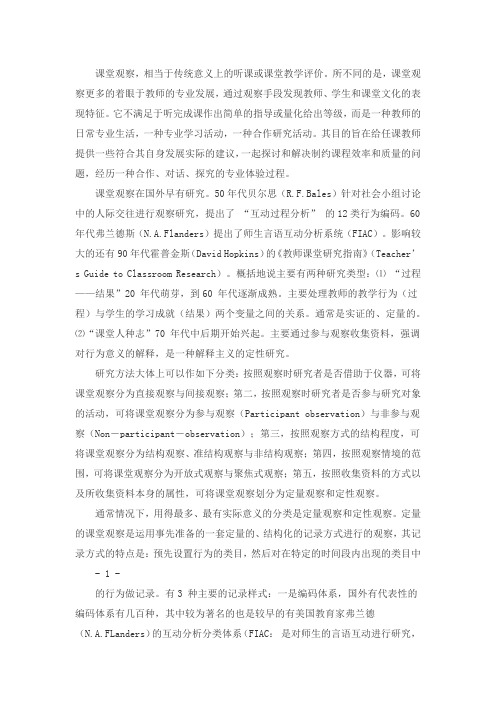
课堂观察,相当于传统意义上的听课或课堂教学评价。
所不同的是,课堂观察更多的着眼于教师的专业发展,通过观察手段发现教师、学生和课堂文化的表现特征。
它不满足于听完成课作出简单的指导或量化给出等级,而是一种教师的日常专业生活,一种专业学习活动,一种合作研究活动。
其目的旨在给任课教师提供一些符合其自身发展实际的建议,一起探讨和解决制约课程效率和质量的问题,经历一种合作、对话、探究的专业体验过程。
课堂观察在国外早有研究。
50年代贝尔思(R.F.Bales)针对社会小组讨论中的人际交往进行观察研究,提出了“互动过程分析”的12类行为编码。
60年代弗兰德斯(N.A.Flanders)提出了师生言语互动分析系统(FIAC)。
影响较大的还有90年代霍普金斯(David Hopkins)的《教师课堂研究指南》(Teacher’s Guide to Classroom Research)。
概括地说主要有两种研究类型:⑴“过程——结果”20 年代萌芽,到60 年代逐渐成熟。
主要处理教师的教学行为(过程)与学生的学习成就(结果)两个变量之间的关系。
通常是实证的、定量的。
⑵“课堂人种志”70 年代中后期开始兴起。
主要通过参与观察收集资料,强调对行为意义的解释,是一种解释主义的定性研究。
研究方法大体上可以作如下分类:按照观察时研究者是否借助于仪器,可将课堂观察分为直接观察与间接观察;第二,按照观察时研究者是否参与研究对象的活动,可将课堂观察分为参与观察(Participant observation)与非参与观察(Non-participant-observation);第三,按照观察方式的结构程度,可将课堂观察分为结构观察、准结构观察与非结构观察;第四,按照观察情境的范围,可将课堂观察分为开放式观察与聚焦式观察;第五,按照收集资料的方式以及所收集资料本身的属性,可将课堂观察划分为定量观察和定性观察。
通常情况下,用得最多、最有实际意义的分类是定量观察和定性观察。
核心素养下初中英语听评课——课堂观察
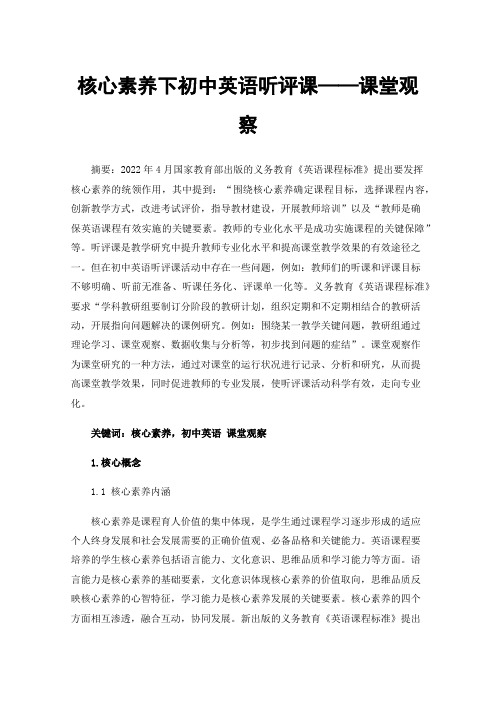
核心素养下初中英语听评课——课堂观察摘要:2022年4月国家教育部出版的义务教育《英语课程标准》提出要发挥核心素养的统领作用,其中提到:“围绕核心素养确定课程目标,选择课程内容,创新教学方式,改进考试评价,指导教材建设,开展教师培训”以及“教师是确保英语课程有效实施的关键要素。
教师的专业化水平是成功实施课程的关键保障”等。
听评课是教学研究中提升教师专业化水平和提高课堂教学效果的有效途径之一。
但在初中英语听评课活动中存在一些问题,例如:教师们的听课和评课目标不够明确、听前无准备、听课任务化、评课单一化等。
义务教育《英语课程标准》要求“学科教研组要制订分阶段的教研计划,组织定期和不定期相结合的教研活动,开展指向问题解决的课例研究。
例如:围绕某一教学关键问题,教研组通过理论学习、课堂观察、数据收集与分析等,初步找到问题的症结”。
课堂观察作为课堂研究的一种方法,通过对课堂的运行状况进行记录、分析和研究,从而提高课堂教学效果,同时促进教师的专业发展,使听评课活动科学有效,走向专业化。
关键词:核心素养,初中英语课堂观察1.核心概念1.1 核心素养内涵核心素养是课程育人价值的集中体现,是学生通过课程学习逐步形成的适应个人终身发展和社会发展需要的正确价值观、必备品格和关键能力。
英语课程要培养的学生核心素养包括语言能力、文化意识、思维品质和学习能力等方面。
语言能力是核心素养的基础要素,文化意识体现核心素养的价值取向,思维品质反映核心素养的心智特征,学习能力是核心素养发展的关键要素。
核心素养的四个方面相互渗透,融合互动,协同发展。
新出版的义务教育《英语课程标准》提出要发挥核心素养的统领作用,并围绕核心素养进行一系列的教育教学工作。
本课题将基于核心素养,将课堂观察与初中英语听评课活动结合起来进行研究,从而使教师的课堂教学更符合课标要求。
1.2听评课听课是一种由活动参与者对授课教师的课堂教学过程进行仔细观察的活动,是提高教师素养,提升教学质量的重要教研方式。
英文课堂观察怎么写作文

英文课堂观察怎么写作文英文,In my English class observation, I noticed that the teacher used a variety of teaching methods to engage the students. For example, she started the class with a discussion about a current event, which not only improved the students' speaking skills but also kept them updated with the world. Then, she used a multimedia presentation to introduce new vocabulary and grammar points, which made the learning process more interactive and interesting.During the class, I also observed that the teacher encouraged the students to participate actively by asking open-ended questions and giving them time to think and respond. This not only improved their speaking and critical thinking skills but also created a supportive and inclusive learning environment. Additionally, the teacher used group activities and pair work to promote collaboration and teamwork among the students, which I believe is essential for their future success.Overall, I was impressed by the teacher's ability to create a dynamic and engaging learning environment in the English class. I believe that her teaching methods not only help the students improve their language skills but also foster a love for learning.中文,在我的英文课堂观察中,我注意到老师使用了各种教学方法来吸引学生。
英语课堂观察的内容及技术手段

英语课堂观察的内容及技术手段课堂观察(classroom observation )即同事间互相协作,相互听课。
观察教师是否合理安排教学过程,如课堂管理、教学方法、学生反应、师生关系等,如何处理课堂教学中的问题,确保教学活动顺利进行。
需要强调的是,课堂观察不是评估教学的手段而是收集信息的途径。
授课教师在课前虽然对课堂活动、任务、时间安排进行精心设计,但设计与实际的教学实施往往存在一定的偏差,因此有必要请同事帮助观察课堂教学,收集教学信息。
在请同事听课时,通常要求他们收集以下几方面的信息:1.课堂组织方面:教师如何开始课堂教学、组织活动?如何结束该课?2.时间分配方面:教师如何分配不同活动的时间?3.学生任务完成情况:学生使用何种策略、步骤来完成课堂任务?相互交流的形式、参与活动的程度和时间如何?4.提问、问答方面:课堂上教师所提问题的类型。
5.教师讲解方面:课堂上教师如何解释生词、语言难点、语篇等?6.教师活动覆盖面:教师与学生交流的范围有多广,是否与某些学生交流更多而忽视另一部分学生?7.学生结对活动方面:学生完成结对活动的方式,在活动中的反应以及所使用的语言,是用英语还是母语,还是两者并用?8.组活动方面:教师以何种方式分组,是随机的还是固定的每个小组的人数学生在小组活动中使用外语和母语的情况,参与活动的积极性。
9.课堂交流方面:课堂上教师与学生、学生与学生之间的交流模式。
10.教材使用方面:课堂上教师对教材的依赖程度如何,以及以何种形式脱开教材?听课教师或授课教师还可以利用表格、清单和条目记录课堂某一行为,或对课堂发生的主要活动作一概括。
此外,课后授课教师可以让学生和听课教师就刚结束的这节课回答如下问题:(1)你认为本课(或某项活动)的主要目的是什么?(2)你(或学生)从本课中真正学到了什么?(3)你认为本课最无效的部分是什么?同时授课教师本人也可回答以上这些问题。
对照三方面的回答,可以得到来自不同方面的反馈意见。
基于教学评一体化的课堂观察
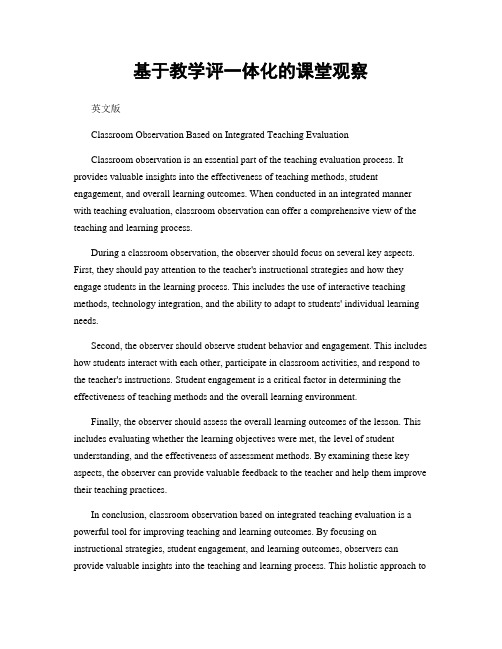
基于教学评一体化的课堂观察英文版Classroom Observation Based on Integrated Teaching EvaluationClassroom observation is an essential part of the teaching evaluation process. It provides valuable insights into the effectiveness of teaching methods, student engagement, and overall learning outcomes. When conducted in an integrated manner with teaching evaluation, classroom observation can offer a comprehensive view of the teaching and learning process.During a classroom observation, the observer should focus on several key aspects. First, they should pay attention to the teacher's instructional strategies and how they engage students in the learning process. This includes the use of interactive teaching methods, technology integration, and the ability to adapt to students' individual learning needs.Second, the observer should observe student behavior and engagement. This includes how students interact with each other, participate in classroom activities, and respond to the teacher's instructions. Student engagement is a critical factor in determining the effectiveness of teaching methods and the overall learning environment.Finally, the observer should assess the overall learning outcomes of the lesson. This includes evaluating whether the learning objectives were met, the level of student understanding, and the effectiveness of assessment methods. By examining these key aspects, the observer can provide valuable feedback to the teacher and help them improve their teaching practices.In conclusion, classroom observation based on integrated teaching evaluation is a powerful tool for improving teaching and learning outcomes. By focusing on instructional strategies, student engagement, and learning outcomes, observers can provide valuable insights into the teaching and learning process. This holistic approach toclassroom observation can help teachers identify areas for improvement and ultimately enhance the overall quality of education.基于教学评一体化的课堂观察课堂观察是教学评估过程中的一个重要组成部分。
Classroom Observation
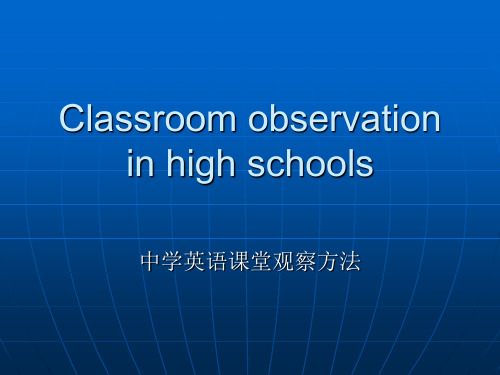
合作的课堂观察
观察的目标和重点分配到多个人,每一个 观察者负责观察量表的某一项或某几项。 观察者以组为单位,每一组负责一项或几 项观察项目,合作完成对一个课堂的观察 活动。
合作课堂观察工作流程
一、课前会议 被观察者说课,简要介绍本课主题和内容,分析教材,说 明教材的二次开发与处理,介绍上课学生的情况,包括思 维特征、学习习惯和课堂氛围,简要说明教学设计和流程 以及预设的学习目标等。 观察者与被观察者还可作进一步的简短交流,目的是让观 察者对本课有更深入的理解,为确定自己的观察点和开发 观察工具提供帮助。 双方商议,确定观察点。
如何正确解读和使用观察数据?
理解量表的理念和目的。
要注意把定量和定性的方法结合起来。 定量的方法使研究有据,通过数据的呈现 归纳出被观察者教学行为特点。定性的方 法着眼于综合观察者从教学设计、课堂文 化与氛围等视角得到的信息或要素,据此 为被观察者提供全景式的改进建议。
课堂观察框架设计有哪些维度?
What’s classroom observation?
课堂观察是教科研的基本方式之一。研究 者或者观察者带着明确的目的,借助自身 感官或相关工具,直接或间接从课堂情景 中收集资料,并依据资料作相应研究的一 种教育科学研究方法。 --崔允漷
What’s classroom observation?
结尾的话
思考了,就研究了。教研并非高不可攀!
教师的魅力=勤奋执着、广泛阅读和深入的 思考。
你们的朋友:金莺 email:jinying318@
课堂观察是一种行为系统
课堂观察是一种研究方式
课堂观察是一种工作流程 课堂观察是一种团队合作
课堂观察法指导Guidelines for Classroom Observation
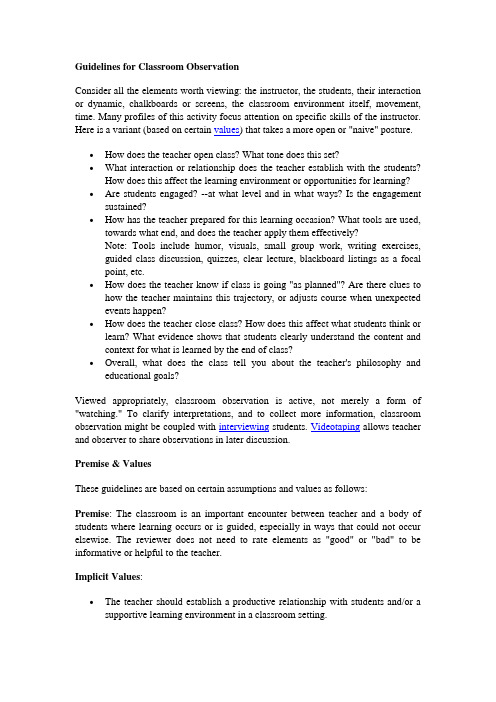
Guidelines for Classroom ObservationConsider all the elements worth viewing: the instructor, the students, their interaction or dynamic, chalkboards or screens, the classroom environment itself, movement, time. Many profiles of this activity focus attention on specific skills of the instructor. Here is a variant (based on certain values) that takes a more open or "naive" posture.∙How does the teacher open class? What tone does this set?∙What interaction or relationship does the teacher establish with the students?How does this affect the learning environment or opportunities for learning?∙Are students engaged? --at what level and in what ways? Is the engagement sustained?∙How has the teacher prepared for this learning occasion? What tools are used, towards what end, and does the teacher apply them effectively?Note: Tools include humor, visuals, small group work, writing exercises, guided class discussion, quizzes, clear lecture, blackboard listings as a focal point, etc.∙How does the teacher know if class is going "as planned"? Are there clues to how the teacher maintains this trajectory, or adjusts course when unexpected events happen?∙How does the teacher close class? How does this affect what students think or learn? What evidence shows that students clearly understand the content and context for what is learned by the end of class?∙Overall, what does the class tell you about the teacher's philosophy and educational goals?Viewed appropriately, classroom observation is active, not merely a form of "watching." To clarify interpretations, and to collect more information, classroom observation might be coupled with interviewing students. Videotaping allows teacher and observer to share observations in later discussion.Premise & ValuesThese guidelines are based on certain assumptions and values as follows:Premise: The classroom is an important encounter between teacher and a body of students where learning occurs or is guided, especially in ways that could not occur elsewise. The reviewer does not need to rate elements as "good" or "bad" to be informative or helpful to the teacher.Implicit Values:∙The teacher should establish a productive relationship with students and/or a supportive learning environment in a classroom setting.∙Student engagement reflects both motivation or interest (attitude) and level of active learning--each important measures of opportunities for learning.∙Classes should be planned and managed to achieve clear goal(s).∙Ability to lecture clearly in a disciplined classroom is only one among many tools for effective teaching. Consider, for example, studios, labs and recitation/problem-solving sessions. Technology, discussion, handouts, etc., are tools only and should not be assessed as ends themselves, rather as means towards an intended outcome (how effectively they are used).∙Students should be able to articulate both what they have learned and its significance。
论教师的课堂观察技能及其培养
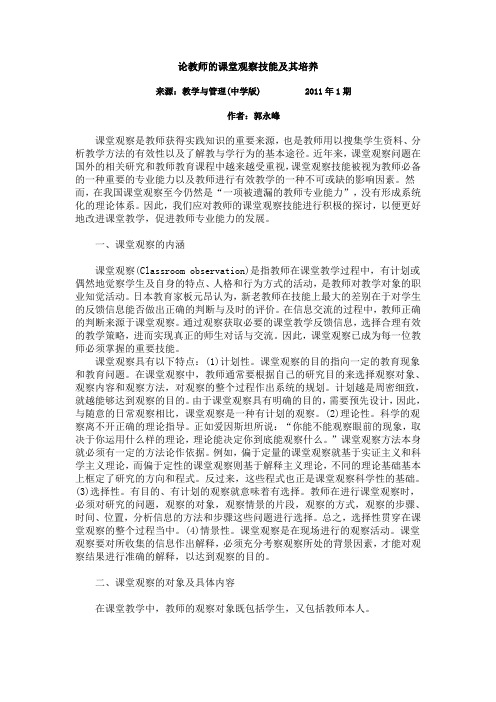
论教师的课堂观察技能及其培养来源:教学与管理(中学版) 2011年1期作者:郭永峰课堂观察是教师获得实践知识的重要来源,也是教师用以搜集学生资料、分析教学方法的有效性以及了解教与学行为的基本途径。
近年来,课堂观察问题在国外的相关研究和教师教育课程中越来越受重视,课堂观察技能被视为教师必备的一种重要的专业能力以及教师进行有效教学的一种不可或缺的影响因素。
然而,在我国课堂观察至今仍然是“一项被遗漏的教师专业能力”,没有形成系统化的理论体系。
因此,我们应对教师的课堂观察技能进行积极的探讨,以便更好地改进课堂教学,促进教师专业能力的发展。
一、课堂观察的内涵课堂观察(Classroom observation)是指教师在课堂教学过程中,有计划或偶然地觉察学生及自身的特点、人格和行为方式的活动,是教师对教学对象的职业知觉活动。
日本教育家板元昂认为,新老教师在技能上最大的差别在于对学生的反馈信息能否做出正确的判断与及时的评价。
在信息交流的过程中,教师正确的判断来源于课堂观察。
通过观察获取必要的课堂教学反馈信息,选择合理有效的教学策略,进而实现真正的师生对话与交流。
因此,课堂观察已成为每一位教师必须掌握的重要技能。
课堂观察具有以下特点:(1)计划性。
课堂观察的目的指向一定的教育现象和教育问题。
在课堂观察中,教师通常要根据自己的研究目的来选择观察对象、观察内容和观察方法,对观察的整个过程作出系统的规划。
计划越是周密细致,就越能够达到观察的目的。
由于课堂观察具有明确的目的,需要预先设计,因此,与随意的日常观察相比,课堂观察是一种有计划的观察。
(2)理论性。
科学的观察离不开正确的理论指导。
正如爱因斯坦所说:“你能不能观察眼前的现象,取决于你运用什么样的理论,理论能决定你到底能观察什么。
”课堂观察方法本身就必须有一定的方法论作依据。
例如,偏于定量的课堂观察就基于实证主义和科学主义理论,而偏于定性的课堂观察则基于解释主义理论,不同的理论基础基本上框定了研究的方向和程式。
课堂观察
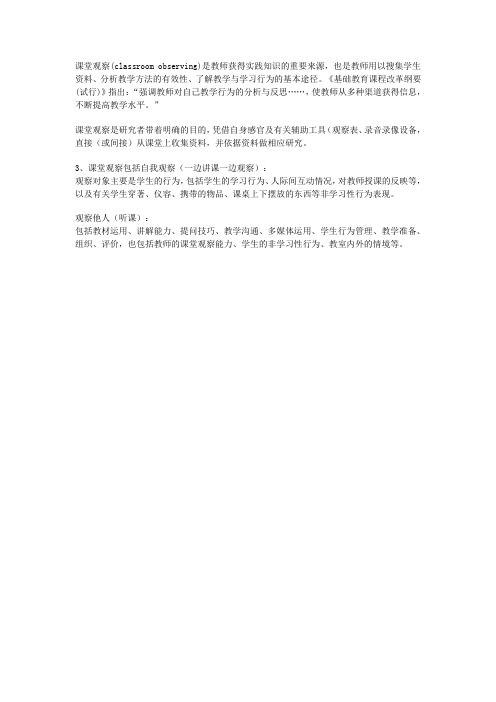
课堂观察(classroom observing)是教师获得实践知识的重要来源,也是教师用以搜集学生资料、分析教学方法的有效性、了解教学与学习行为的基本途径。
《基础教育课程改革纲要(试行)》指出:“强调教师对自己教学行为的分析与反思……,使教师从多种渠道获得信息,不断提高教学水平。
”
课堂观察是研究者带着明确的目的,凭借自身感官及有关辅助工具(观察表、录音录像设备,直接(或间接)从课堂上收集资料,并依据资料做相应研究。
3、课堂观察包括自我观察(一边讲课一边观察):
观察对象主要是学生的行为,包括学生的学习行为、人际间互动情况,对教师授课的反映等,以及有关学生穿著、仪容、携带的物品、课桌上下摆放的东西等非学习性行为表现。
观察他人(听课):
包括教材运用、讲解能力、提问技巧、教学沟通、多媒体运用、学生行为管理、教学准备、组织、评价,也包括教师的课堂观察能力、学生的非学习性行为、教室内外的情境等。
教学观察的理论及运用
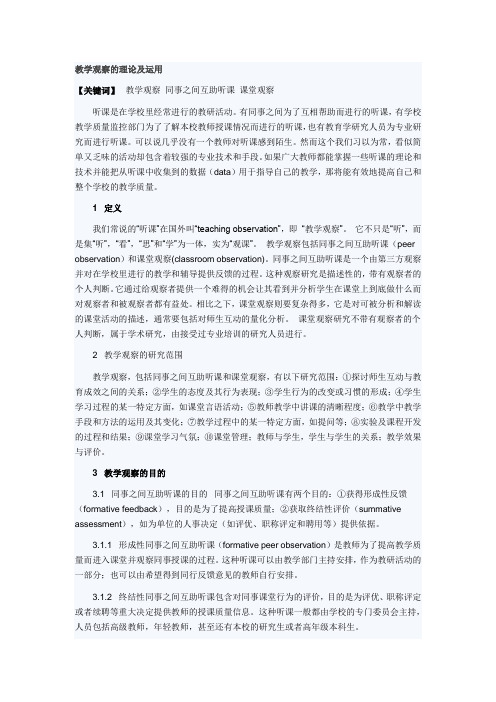
教学观察的理论及运用【关键词】教学观察同事之间互助听课课堂观察听课是在学校里经常进行的教研活动。
有同事之间为了互相帮助而进行的听课,有学校教学质量监控部门为了了解本校教师授课情况而进行的听课,也有教育学研究人员为专业研究而进行听课。
可以说几乎没有一个教师对听课感到陌生。
然而这个我们习以为常,看似简单又乏味的活动却包含着较强的专业技术和手段。
如果广大教师都能掌握一些听课的理论和技术并能把从听课中收集到的数据(data)用于指导自己的教学,那将能有效地提高自己和整个学校的教学质量。
1 定义我们常说的“听课”在国外叫“teaching observation”,即“教学观察”。
它不只是“听”,而是集“听”,“看”,“思”和“学”为一体,实为“观课”。
教学观察包括同事之间互助听课(peer observation)和课堂观察(classroom observation)。
同事之间互助听课是一个由第三方观察并对在学校里进行的教学和辅导提供反馈的过程。
这种观察研究是描述性的,带有观察者的个人判断。
它通过给观察者提供一个难得的机会让其看到并分析学生在课堂上到底做什么而对观察者和被观察者都有益处。
相比之下,课堂观察则要复杂得多,它是对可被分析和解读的课堂活动的描述,通常要包括对师生互动的量化分析。
课堂观察研究不带有观察者的个人判断,属于学术研究,由接受过专业培训的研究人员进行。
2 教学观察的研究范围教学观察,包括同事之间互助听课和课堂观察,有以下研究范围:①探讨师生互动与教育成效之间的关系;②学生的态度及其行为表现;③学生行为的改变或习惯的形成;④学生学习过程的某一特定方面,如课堂言语活动;⑤教师教学中讲课的清晰程度;⑥教学中教学手段和方法的运用及其变化;⑦教学过程中的某一特定方面,如提问等;⑧实验及课程开发的过程和结果;⑨课堂学习气氛;⑩课堂管理;教师与学生,学生与学生的关系;教学效果与评价。
3 教学观察的目的3.1 同事之间互助听课的目的同事之间互助听课有两个目的:①获得形成性反馈(formative feedback),目的是为了提高授课质量;②获取终结性评价(summative assessment),如为单位的人事决定(如评优、职称评定和聘用等)提供依据。
2019初中地理课堂案例观察法实施语文
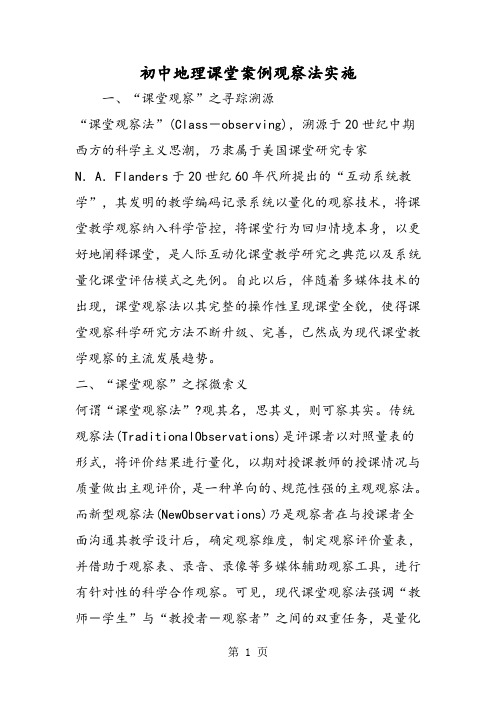
初中地理课堂案例观察法实施一、“课堂观察”之寻踪溯源“课堂观察法”(Class-observing),溯源于20世纪中期西方的科学主义思潮,乃隶属于美国课堂研究专家N.A.Flanders于20世纪60年代所提出的“互动系统教学”,其发明的教学编码记录系统以量化的观察技术,将课堂教学观察纳入科学管控,将课堂行为回归情境本身,以更好地阐释课堂,是人际互动化课堂教学研究之典范以及系统量化课堂评估模式之先例。
自此以后,伴随着多媒体技术的出现,课堂观察法以其完整的操作性呈现课堂全貌,使得课堂观察科学研究方法不断升级、完善,已然成为现代课堂教学观察的主流发展趋势。
二、“课堂观察”之探微索义何谓“课堂观察法”?观其名,思其义,则可察其实。
传统观察法(TraditionalObservations)是评课者以对照量表的形式,将评价结果进行量化,以期对授课教师的授课情况与质量做出主观评价,是一种单向的、规范性强的主观观察法。
而新型观察法(NewObservations)乃是观察者在与授课者全面沟通其教学设计后,确定观察维度,制定观察评价量表,并借助于观察表、录音、录像等多媒体辅助观察工具,进行有针对性的科学合作观察。
可见,现代课堂观察法强调“教师-学生”与“教授者-观察者”之间的双重任务,是量化记录与质化评价的相互融合,是一种专业、高效、互动的教学评价法。
三、“课堂观察”之纲举目张根据笔者在课堂观察中的初步实践,将观察法分类为“团队观察法”、“个体观察法”以及“自我观察法”。
团队观察法以学校地理教学科研组以及课题组为观察者,对教师的教学情况进行“质+量”的考查,对学生的学习状态进行分时与分类的评估,以期进行针对性的反馈;个体观察法则以观察表格标记授课者的课堂主题、细节问题以及情境表现,最终反馈给授课者,要求其进行反思并反馈;自我观察法则是授课者对自我课堂表现的观察与反思,以课后反思、课堂笔录以及回忆笔记的形式对自己的课堂教学质量进行客观评估。
- 1、下载文档前请自行甄别文档内容的完整性,平台不提供额外的编辑、内容补充、找答案等附加服务。
- 2、"仅部分预览"的文档,不可在线预览部分如存在完整性等问题,可反馈申请退款(可完整预览的文档不适用该条件!)。
- 3、如文档侵犯您的权益,请联系客服反馈,我们会尽快为您处理(人工客服工作时间:9:00-18:30)。
2.2 Teaching Contents
➢Short video about how to define success ➢Questions to discuss:
Ss work in groups to discuss several questions about success and dream
Watch a video
How do you define success?
12
Show Time
Write down tips on how to succeed.
1. What are symbols of success? 2.How can we preserve the dream? 3.What are the common features of successful people? …
➢ Listening about a short passage about attitude ➢Quotes on success
3. Listening
• Listen and Respond sectionA:word bank (Ss read new words and choose one to lead Ss to read in
room Observation
Pensent by
P A R T 01 Introduction P A R T 02 Observation Frame P A R T 03 Conclusion
01 Introduction
Introduction
1.1 Target text
2.3 Teaching Implementation
Warm up
Discussion
Listening
Quotes
Get Started
1. Warm Up
• Watch a video Qs: How to define success?
How about their suggestions to others? • Activity(Pair Work) Q: How do you define your success?
(write a note and put it on the blackboard to share with
classmates)
1. Warm Up
• Watch a video Qs: How to define success?
How about their suggestions to others? • Activity(Pair Work) Q: How do you define your success?
02
Observation Frame
Observation Frame Teacher's teaching
Students' learning
Nature of the course
Classroom culture
崔允漷. 论课堂观察LICC范式:一种专业的听评课[J]. 教育研究, 2012(5):79-83.
Zooming In: An Integrated English
Course Unit 3 The Road to
Success
1.2 Target students
Non-English major 1st year college students
1.3Observation Time
90 mins
1 Language objectives
2 Ability objectives
3 Moral objectives
master some words: trainer, someday, acre, detail, realistic, reconsider...
improve: 1.listening and speaking skills; 2.predicting skill; 3.note-taking skill; 4.critical thinking ability.
build up true value, and try to find a suitable lifestyle.
These objectives are specific, exercisable, creative and scientific.
New Curriculum Standard requires to cultivate students' comprehensive language application ability, so these objectives conforms to it.
Choose a reporter to present their results.
group 1
group 2
group 3
group 4
(Here is students' cooperation,and there are interactions between students and teachers.)
2. Discussion (Group Work)
Ss work in groups to discuss several questions about success and dream, and then choose a reporter to present their results.
Nature of the course
2.1
Teaching Objectives
2.3
Teaching Implementation
2.5
resources
2.2
Teaching Contents
2.4
Evaluation
2.1 Teaching Objectives
By the end of this lesson, students should be able to:
